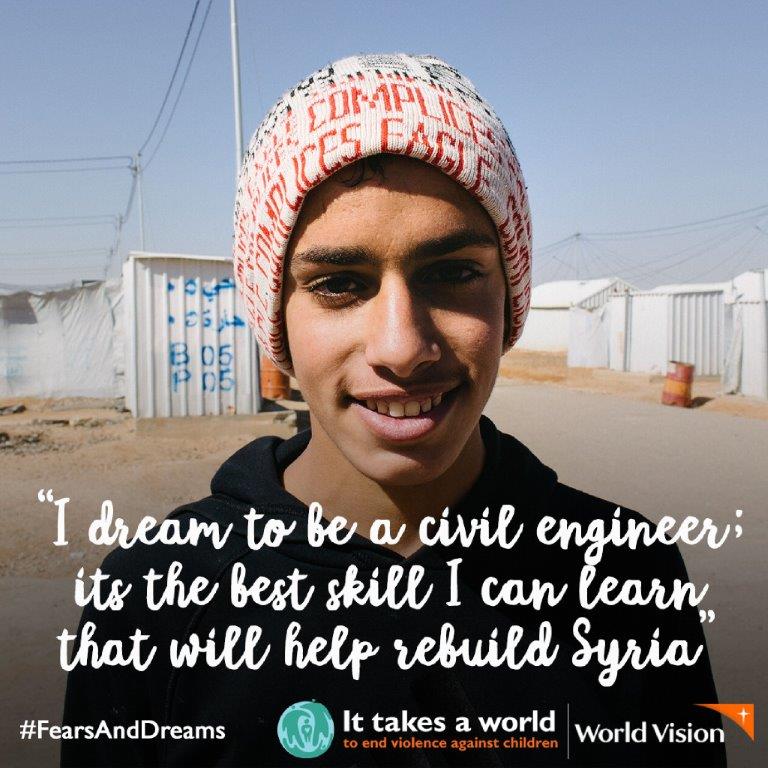Australia Can Do More On Syria: Tim Costello
Wednesday, March 15, 2017

On the anniversary of six years of horrific war in Syria, World Vision Australia chief advocate Tim Costello has urged Australia to continue to agitate for peace and to take more Syrian refugees.
Writing in The Huffington Post, Rev Costello said: “Australia is distant from Syria, but we have a role to play. The Australian Government must continue to agitate for peace and work with the international community to enable rapid and unimpeded humanitarian access to civilians in need. The Australian Government should also work with Australian NGOs to address the funding gaps that exist in the education sector, including expanding learning spaces, investing in remedial education, catch-up classes, non-formal education and psychosocial support for crisis-affected children.
“Given the scale of global needs and Australia’s relative wealth and ability to assist, the Australian Government should also build on its commitment to accept 12,000 Syrian and Iraqi refugees by committing to increase its overall refugee intake to 20,000 this financial year, 30,000 in two years’ time (2018/19), and 42,000 in five years’ time (2020/21). Special consideration should be made for Syrian refugees as long as the conflict and related refugee crisis persists.”
As Syria marks six years of civil war, delegations from Russia, Iran and Turkey have arrived in Astana, Kazakhstan, for a third round of peace talks. Syrian rebel groups have stayed away, blaming Russia's unwillingness to end air strikes against civilians in rebel-held areas and its failure to put pressure on the Syrian army to abide by a widely violated ceasefire.
In Geneva, a fourth round of parallel UN-led talks, dubbed Geneva 4, have also just ended, fruitlessly, with opposition demands for “political transition” looking increasingly forlorn as the tide of war shifts decisively in favour of Syrian president Bashar al Assad. Between Geneva 3 and Geneva 4, Russian-backed Syrian government forces retook the city of Aleppo and are now bearing down on the Islamic State stronghold of Raqqa, along with Kurdish-led Syrian fighters backed by the US.
After 6 years of war, a map of Syria now shows much of the west of the country in government control, a large swathe of territory in the north controlled by Kurdish forces, strips of territory held by ISIS and patches north and south controlled by disparate anti-government groups, including the Free Syrian Army, Jaysh al-Islam, Ahrar al-Sham, and Jabhat Fateh al-Sham, formerly known as al- Nusra, which is seeking to reassert itself and recently claimed responsibility for twin bombings near a Shiite shrine in Damascus, which left 40 dead.
“It is a patchwork of misery,” Rev Costello said.
“If the war has swung towards Assad, peace and stability are still not close and with each passing year, the consequences of war have become more catastrophic.
“In six years, somewhere between 270,000 and 450,000 people have been killed and more than 11 million of Syria's pre-war population of 22 million (roughly the same population as Australia) have been forced from their homes. More than 6 million are displaced within Syria, almost 5 million turned into refugees. Half of them are children.
“A generation of Syrian children is emerging whose lives have been shaped by war and displacement: bombings, death, injuries, grief, toxic stress, recruitment into armed groups, child labour, child marriage, sexual violence, exploitation. This is what they know.”
According to the United Nations children’s organisation, UNICEF, at least 652 Syrian children were killed this past year, while more than 850 children were recruited to fight.
A generation of Syrian children is also growing up with little or no education.
According to the UN, 1.7 million children inside Syria aged 5-17, and 700,000 Syrian refugee children are not receiving any education, with a further 1.3 million at risk of dropping out. It is an educational wasteland. Syrians see their tragedy in the faces of their children.
To mark Syria’s six years of war, World Vision interviewed children about their fears and dreams: Syrian refugee children living in Turkey, Jordan and Lebanon, and children in Australia, Canada, NZ, Germany, Ireland and Korea.
Almost half the Australian children said they dreamed of success, while an unexpectedly high 35 per cent said they were most afraid of war and terrorism, without ever having experienced it.
The fears of Syrian refugee children were more precise and based on what they have seen: bombs falling, families destroyed, homes obliterated. The survey found that 43 per cent of Syrian children feared airstrikes, shelling and explosions the most.
But their dreams were not very different – to be safe, to be happy, to have a life, to return to Syria, to become teachers and engineers and doctors, even though their education has been stopped in its tracks. About half the Syrian children surveyed said they dreamed of peace and returning home to Syria, a third said they dreamed of having a career, and a further 12 per cent said they dreamed of being reunited with a lost loved-one.
Tim Costello is World Vision Australia chief advocate
For further information, contact: Stuart Rintoul 0407 241 492
Media Releases,
Syria,
Tim Costello
Back to all Results